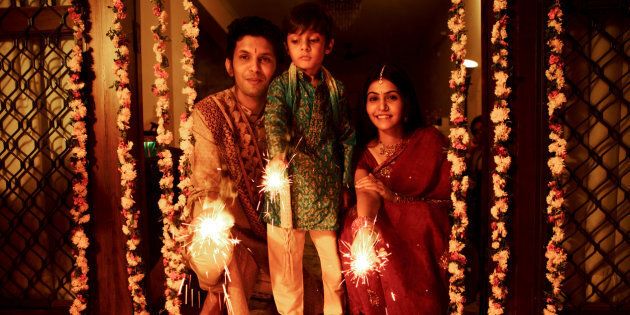
I will be out of town for this weekend's Diwali festival -- the Hindu celebration of light that honours goodness over evil -- the most significant Indian celebration of the year. To be honest, I'm pretty crushed about it. But the date of Diwali changes every year in accordance with the Hindu calendar, meaning that my sisters and I rely on our mother to tell us when it is. So it's her fault, really, that months ago I locked in a much-anticipated kid-free girls' trip on a friend's boat on a tropical island, without realising what I'd be missing.
Diwali, which honours the Hindu goddess of wealth, Lakshmi, means four things to me: Family, Fun, (stuffing your) Face, and FIRE (explained below). Diwali has been part of my life for as long as I can remember, so my absence this year from the family celebration that is always organised solely by my poor mother made me realise that I am an adult and could probably pull a nautical-themed Diwali together myself -- but boats and flames (and alcohol) don't really mix.
There are hundreds of thousands of Australians who will be celebrating Diwali this weekend; most of us probably know someone who is. It was amazing to see the Sydney Opera House last week lit in gold light to mark the commencement of celebrations; a wonderful acknowledgment of Diwali's significance, in a similar way to how Aussies have embraced Chinese New Year.
Doing your own Diwali is something that can easily be achieved, and it's a brilliant way to teach your family about other cultures and traditions.
Here are the essential elements of Diwali:
1. Candles and lights
This is the one night where my mother permits every light in the house to be on at the same time. Candles are lit and placed on window sills and outside, to invite the goddess Lakshmi to bless the house with good fortune. It is a relaxing and beautiful thing to do, as you light each candle, and think about how lucky your life already is.
2. Prayers
My mother leads us in Hindu songs and prayers, which, having repeated every year in my living memory, I pretty much know word for word. My sisters and I battle it out to show mum who knows it the best.
The prayers happen at my mother's altar, which is adorned in fresh flowers and candles. (This makes it hard not to think of 'The Bachelor' -- sorry, Mum.) It also includes a brief time for silent reflection, where we think about our gratitude for the life we have and our hopes for the future. (This is also where my sisters and I try not to make eye contact, because silence is funny no matter how old you are.)
3. Fruit
A silver tray of cut up fruit is offered as food to the Gods during the prayers -- and then consumed by us. This always involves fruit trading between siblings. Usually served with nuts and a sweet semolina dish called Hulva.
4. Dinner
Only vegetarian food can be served at Diwali. The meal usually includes rice, rotis, dhal, and various forms of potato, eggplant and spinach curries. My mother has recipes, and, of course, a magic touch that I can't re-create, so I'll direct you to Padma Lakshmi and The Heart Foundation's recipes -- because authentic Indian food is nowhere near as rich or fatty as the dishes usually served in restaurants.
5. Indian sweets
These are sold by many Indian/Asian grocers and Indian restaurants, or you could try making some yourself to add a wow-factor to your dessert repertoire. Jalebis and gulab jamuns are my absolute favourites, and the kids LOVE them.
6. Fire
Arguably the best part of the night involves rolling yourself outside after dinner to indulge in some pyromaniacal behaviour. Sparkler after sparkler is lit as the kids go nuts in the dark, twirling around, writing their names in flashes of light and/or whinging that their sparkler has run out. The photos of the kids with their faces lit by sparklers and unbridled glee are priceless. In India, fireworks are lit and joyfully watched in every community.
7. Money
Cold hard cash is handed out by the elder generation (Mum) to the younger generation (my sisters and our kids). Thanks to my sisters having more children than I do, they fare better -- but, you know, that's cool. It is a traditional gesture of goodwill, and after a decade (of this gross inequality) since the birth of the first grandchild, I barely even notice (this massive injustice) anymore.
So, that's Diwali for you. I hope you can celebrate the Festival of Lights in some small way -- just don't forget to buy matches.